Melanie Howard describes how the modern world of illusion and image is driving people to seek a more authentic reality
THE FUTURE Foundation has been monitoring an aspirational trend we call Authentiseeking for more than five years now. Born of a confluence of three other long-term trends in our stable – Ethical Consumerism, Local Preference, and the Simplification of Complexity – this is about a powerful urge that many people feel to get in touch with what they believe is a more ‘real’ world.
The idea of what constitutes an authentic, unmediated way of living is, of course, a fascinating construct to explore and one that has multiple components. It is also driving a demand for new services among marketers and innovators from firms in our line of work, thus creating a strong business-to-business angle to consider.
For example, business people have an increasing desire to get out of the office, away from the computer and to be exposed to raw and unpredictable experiences, including debates, lectures and tours. The IPA recently took agency heads to China and Silicon Valley as the most effective way of learning what is really happening.
The idea of consumer safaris that provide direct access to curated experiences in the same physical space as craftspeople, and niche services targeted at specific consumer groups, is gaining momentum. One example is the Liminal Space, run by artists and designers in London. People can choose from myriad events, debates and tours, such as art tours with House 7 (organised by the Soho House group) and high level debates with Intelligence Squared, which provides privileged access to the intellectual and cultural coalface for those needing ideas, inspiration and insights.
For many consumers, Authentiseeking is about a return to a more natural mode of existence – in harmony with nature and our ‘true selves’ – as an antidote to the consequences of mass production and the consumer society in an increasingly urbanised world. Rural sociologists from Newcastle University, working with us on a Defra-funded scenario project on the future of the countryside, described it as ‘symbolic rurality’, by which they meant the idealised image of the countryside that we all carry around in our heads, and want to be there for us, even if we find it almost impossible to leave the city these days.
More than 50% agree that they feel a need to be closer to the country, rising to two-thirds among the baby boomer age group. This certainly contributes to a desire for second homes, although fewer than 10% actually own one. And it doubtless drove the much-heralded ‘downshifting’ trend that was widely discussed by journalists in the quality press in the late 1990s – although by our calculations, only 7% of people could ever have afforded to seriously consider this option.
There is also a more challenging explanation of the Authentiseeking trend. Jean Baudrillard, the recently deceased French social theorist, described daily lives in the modern world as becoming a negation of reality as we once understood it. With proliferating communications channels, now filled with signs and symbols constructed to communicate and promote the products and services of the consumer society, he argued that we effectively live in a simulacrum that simulates physical and emotional reality. But, being an ersatz representation, it is less able to satisfy our real needs.
The growing amount of screen time that each of us is now devoting to the range of digital devices we own could be accentuating the potential scope and depth of the simulation.
We spend more than 10 hours a week on average online and nearly half of the UK population is extending that through ownership of a smartphone. It is no surprise that many express the need to get away from it all – from the 60% who agree that they sometimes want to just switch off their phones and computers, to the 40% who now define luxury in terms of relaxation and escape, rather than material goods – suggesting a wish to get behind the façade and reconnect with our true self.
Clearly this creates a challenge for marketers and advertisers – how can we communicate a brand’s authenticity using the complex language of signs in the digitally facilitated world that is creating the simulacrum itself? No wonder semioticians are becoming more a part of the toolkit of insight and analysis.
Jack Daniel’s current advertising is a good example of how the emphasis on the real, the slow and heritage can work for a smaller niche brand. Divine chocolate puts the accent on its co-owning grower community – ethics and authenticity are mutually reinforcing. Oxfam offers visits to overseas projects as a prize for supporters in a regular draw and Asda now provides live feeds from webcams in farms and factories around the world.
Authentiseeking may be well established, but it is gathering momentum in response to the spread of digital interaction and our long-term responses to the reality of living in the urbanised consumer world.
This article featured in Market Leader, July 2012.
Melanie Howard is chair of the Future Foundation and a non-executive director of TCA.
